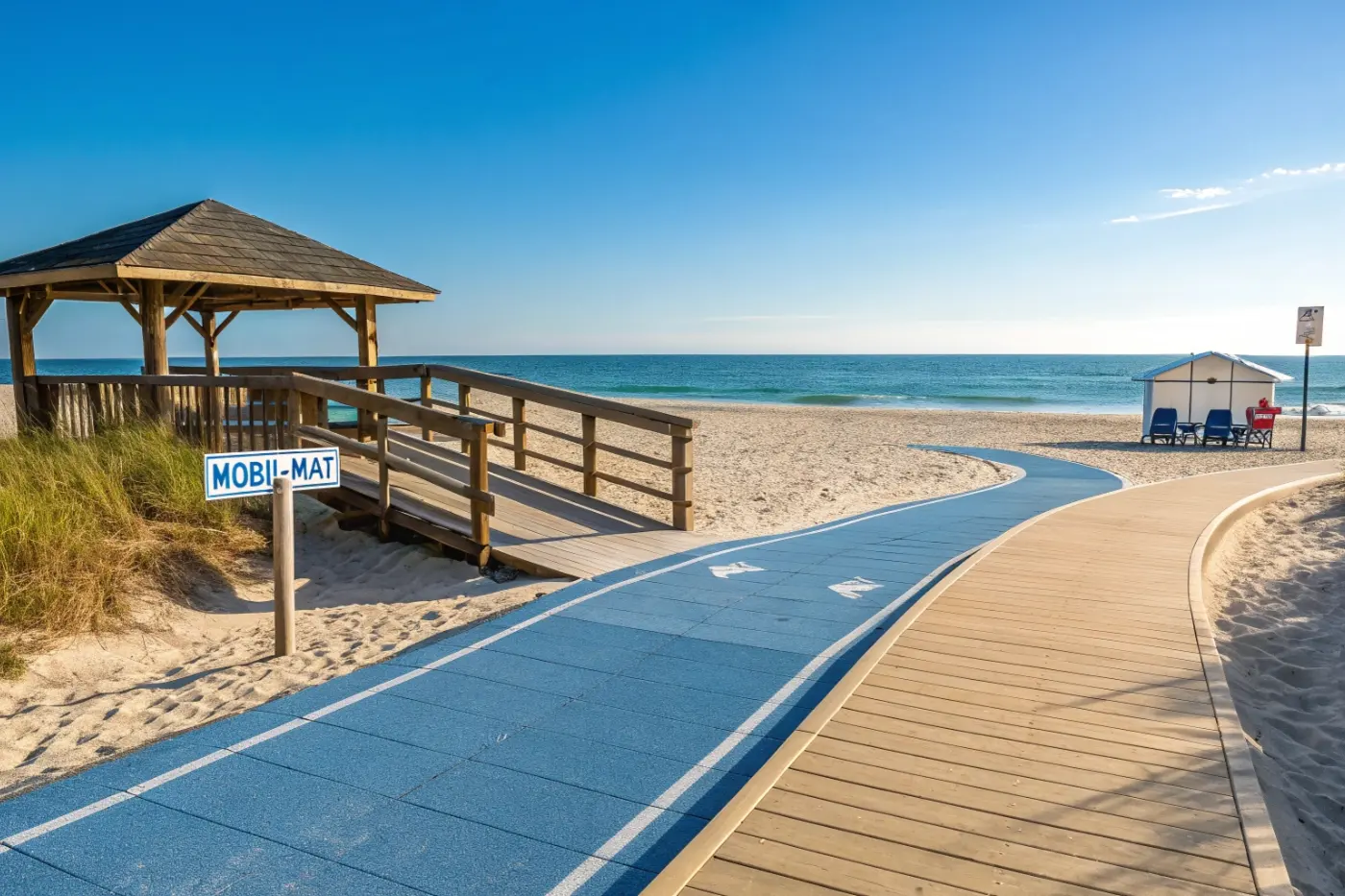Table Of Contents
Table of Contents
Beaches are supposed to be for everyone, right? Whether you’re soaking up the sun, splashing in the waves, or simply enjoying the salty breeze, the beach should be a place where everyone feels welcome. But for many people with disabilities, finding ADA accessible beaches can be a challenge. Thankfully, more beaches are prioritizing inclusivity and making sure everyone can enjoy the sand and surf. In this guide, we’ll explore what makes a beach ADA accessible, highlight some of the best wheelchair-friendly beaches across the U.S., and share tips for planning your next beach adventure.
What Makes a Beach ADA Accessible?
When we talk about ADA (Americans with Disabilities Act) accessibility, we’re ensuring that public spaces, including beaches, are usable by people with disabilities. For a beach to truly be ADA accessible, it needs to accommodate visitors with mobility challenges, sensory impairments, or other disabilities. Let’s break down the key features that make a beach wheelchair-friendly.
Key Features of Wheelchair-Friendly Beaches
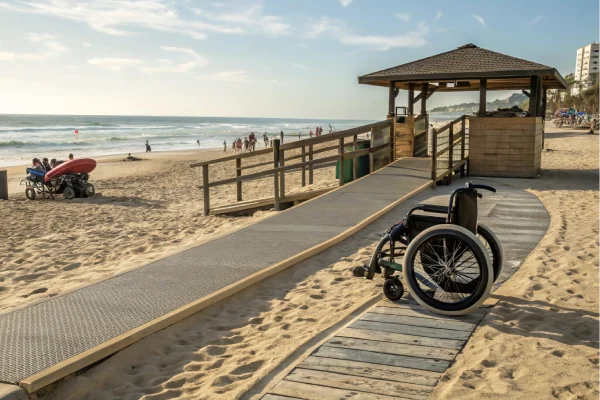
- Accessible Pathways:
Narrow, uneven boardwalks or excessively sandy paths can be barriers for wheelchair users. Look for beaches with paved pathways that provide a smooth, obstacle-free route from parking areas to the sand. - Beach Wheelchairs:
Many beaches offer beach wheelchairs for rent or free use. These lightweight chairs are designed to handle soft sand and allow users to move across the beach with ease. - Ramps:
If the beach is separated by a retaining wall or dune, there should be ramps that provide safe, accessible entry points to the sand. - Mobi-Mats:
These heavy-duty mats are placed over soft sand to create a firmer surface, making it easier for wheelchair users to navigate the beach. - Accessible Parking:
Designated ADA parking spots should be available close to the beach to reduce the distance someone has to travel from their vehicle to the sand. - Restrooms:
Accessible restrooms with grab bars, non-slip floors, and sufficient space for wheelchairs are essential for a comfortable beach experience. - Accessible Shelters or Seating:
Covered seating areas or gazebos provide shade and a place to rest, ensuring that everyone can enjoy the beach without feeling rushed. - TTY Lines and Visual Alarms:
For visitors who are deaf or hard of hearing, beaches should offer alternative communication methods, such as TTY lines or visual alarms for emergencies.
Importance of ADA Compliance for Coastal Recreation
Ensuring that beaches are ADA compliant isn’t just about ticking a box—it’s about fostering inclusivity and promoting independence. When beaches are accessible, people with disabilities can enjoy the same freedoms as everyone else: catching waves, building sandcastles, or simply soaking up the sun.
Accessibility also has a ripple effect on communities. Families, friends, and caregivers of people with disabilities are more likely to visit beaches that are wheelchair-friendly, boosting local economies and creating a more welcoming coastal culture.
8 Wheelchair-Friendly Beaches Across the U.S.
Now, let’s take a look at some of the best ADA accessible beaches in the United States. From the sunny shores of California to the Gulf Coast, these beaches are perfect for travelers looking for inclusive outdoor fun.
1. Santa Monica Beach, California
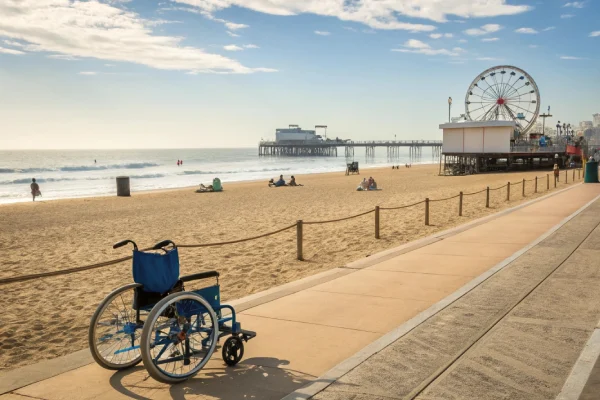
Santa Monica Beach is a hotspot for fitness enthusiasts and beach lovers alike. But it’s also one of the most wheelchair-friendly beaches on the West Coast. The beach offers free beach wheelchairs for rent, and there’s a paved pathway leading from the parking area to the sand.
- Pro Tip: For a fun twist, rent a sand scooter or electric beach buggy for an extra adventurous day at the beach!
2. Canaveral National Seashore, Florida
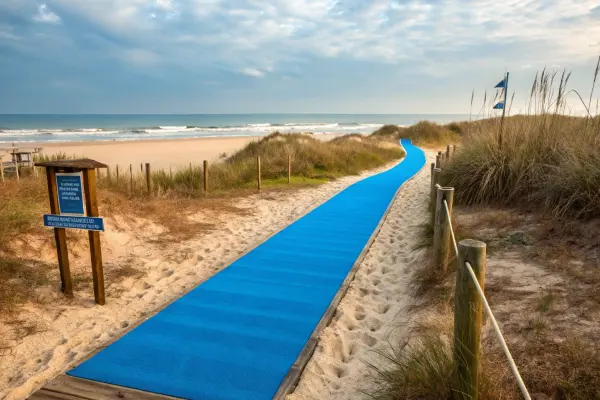
Located on Florida’s central east coast, Canaveral National Seashore is a nature lover’s paradise. This beach is equipped with Mobi-Mats to make the sand more accessible, and there’s a designated ADA parking spot close to the beach.
- Fun Fact: The beach is also a great spot for wildlife enthusiasts, as it’s home to sea turtles, manatees, and rare shorebirds.
3. Huntington Beach, California
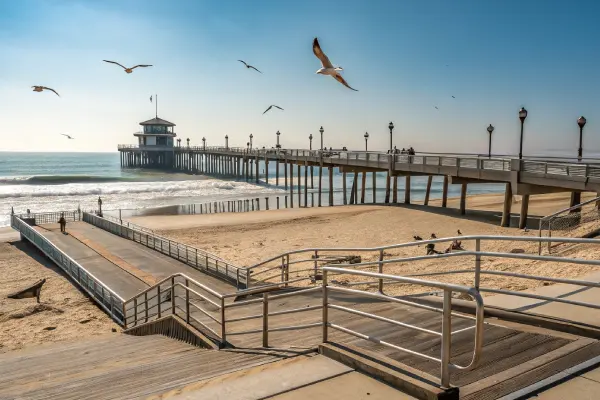
Known as “Surf City USA,” Huntington Beach offers something for everyone, including those with mobility challenges. The beach provides free sand wheelchairs on a first-come, first-served basis, and there are accessible restrooms and showers available.
- Tip: The Huntington Beach pier is also wheelchair accessible, offering stunning views of the Pacific Ocean.
4. Cape Henlopen State Park, Delaware
This Delaware gem is a favorite among beachgoers who want to unwind in nature. Cape Henlopen State Park features accessible trails, beach wheelchairs, and even sensory-friendly programs like beach yoga.
- Best For: Families with young children, as the park also has an aeronautical visitor center and educational programs.
5. Myrtle Beach, South Carolina
Myrtle Beach is a year-round destination that’s perfect for beach enthusiasts. The beach offers accessible entry points via ramps and has programs that provide beach wheelchairs for rent during peak seasons.
- Pro tip:** Explore the nearby WaterWheel at Myrtle Beach, an all-accessible boardwalk with stunning views of the ocean.
6. Galveston Island, Texas
Galveston Island is famous for its historic Strand District, but it’s also a great spot for accessible beach fun. The beach offers sand wheelchairs and has ADA-compliant pathways and boardwalks.
- Must-See: Don’t miss the nearby Galveston Pier 21, which is fully accessible and offers great photo opportunities.
7. Lake Michigan’s Bradford Beach, Wisconsin
Bradford Beach in Milwaukee is one of the Midwest’s best kept secrets. The beach has Mobi-Mat surfaces, accessible restrooms, and provides beach wheelchairs for rent.
- Cool Feature: The beach is also dog-friendly, so you can bring your furry friend along for a day of fun.
8. Revere Beach, Massachusetts
Revere Beach, located just outside Boston, is one of the East Coast’s most charming beach destinations. The beach features paved pathways, and accessible restrooms, and is close to Boston’s public transportation, making it an ideal spot for urban visitors.
- Tip: If you’re staying in Boston, consider taking the commuter rail to Revere Beach for a day trip.
Tips for Planning an ADA Accessible Beach Visit
Planning an accessible beach trip doesn’t have to be complicated. By doing a little research and preparing ahead of time, you can ensure a smooth and enjoyable experience.
Check the Availability of Equipment in Advance
Before heading to the beach, contact the park or beach management to confirm the availability of beach wheelchairs, Mobi-Mats, or other accessibility equipment. Some beaches may require reservations, especially during peak seasons.
Consider Weather and Tide Conditions
Weather can play a big role in beach accessibility. Wet sand can be harder to navigate, especially if you’re using a mobility device or beach wheelchair. Check the forecast and plan your visit for a day with calm winds and warm temperatures.
Pack Essentials for Comfort and Safety
Bring along items like sunscreen, hats, and protective clothing to stay safe in the sun. If you’re renting a beach wheelchair, don’t forget to pack water bottles, snacks, and any medications you might need during the day.
Advocating for Improved Beach Accessibility
While there are many ADA-accessible beaches around the U.S., there’s still work to be done to make all beaches inclusive. As a visitor, you can play a role in advocating for better accessibility.
Supporting Organizations Promoting Inclusive Coastal Access
Groups like the Accessible Nature and the ADA National Network work tirelessly to promote accessible outdoor spaces, including beaches. Consider supporting these organizations by donating or sharing their mission with others.
How to Provide Feedback to Beach Management
If you’ve had an experience at a beach—either positive or negative—share your feedback with the park’s management team. Constructive feedback can help improve accessibility for future visitors.
FAQ Section: Accessibility at Beaches
Can wheelchair users go to the beach?
Yes! Many beaches are now designed with accessibility in mind, offering features like paved pathways, ramps, beach wheelchairs, and Mobi-Mats. These improvements make it easier for wheelchair users to navigate the sand and enjoy the shoreline. Always check with the beach in advance to confirm available accessibility features.
What is ADA accessible?
ADA accessible means that a location or facility complies with the Americans with Disabilities Act (ADA), ensuring that people with disabilities can use it safely and independently. For beaches, this includes features like wheelchair-accessible pathways, ramps, designated parking, restrooms with grab bars, and specialized beach equipment.
How do you make a beach accessible?
Making a beach accessible involves adding features such as:
Mobi-Mats or boardwalks for smooth access over sand
Beach wheelchairs for better mobility
Ramps instead of stairs for easy entry
Accessible restrooms with wide doors and grab bars
Designated ADA parking close to the beach entrance
These modifications help ensure that everyone, regardless of mobility, can enjoy the beach.
What are ADA accessible heights?
ADA guidelines specify different height requirements for accessibility:
Handrails & grab bars: 34–38 inches from the ground
Accessible restroom sinks: Maximum 34 inches high
Signage: Between 48–60 inches for visibility
Tables & counters: 28–34 inches for easy wheelchair access
Beaches that meet these height standards help create a more inclusive environment for all visitors.
Final Thoughts on Inclusive Beach Experiences
ADA accessible beaches are more than just a trend—they’re a statement of inclusivity and equality. By prioritizing accessibility, beaches are creating opportunities for everyone to enjoy the beauty of the coast, regardless of age or ability.
As awareness of accessibility needs grows, we can expect to see more beaches making the necessary changes to accommodate all visitors. Until then, the beaches featured in this guide are a great starting point for planning your next beach adventure.
So, whether you’re a local looking for a new favorite spot or a traveler exploring the U.S., we hope this guide has inspired you to hit the beach and enjoy the sand, surf, and sunshine.
Happy travels!

